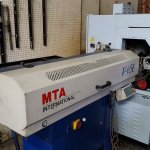conceptdevelopers
Cast Iron
- Joined
- Jun 16, 2007
- Location
- Garland TX
We have a cnc lathe, Hurco TM6i. A job is coming up making 400 some odd pins of various lengths out of 1.0" 4340. We are going to buy 12' sticks and the average pin is 4" long. We have not had such a quantity of parts before so we haven't had a need to hold material that long. How do you use the steady to hold the material safely outside the machine while turning while using a bar puller to advance the stock? Is there some other way I'm not thinking of to do it?


 . If this thing comes loose, you can do tremendous damage and/or injury + death to anyone in the vicinity. Also you would need several of them, so you don't have a couple feet of bar swinging free.
. If this thing comes loose, you can do tremendous damage and/or injury + death to anyone in the vicinity. Also you would need several of them, so you don't have a couple feet of bar swinging free. 

 ....did you see how the machine was moving around on a ''centre point''
....did you see how the machine was moving around on a ''centre point''